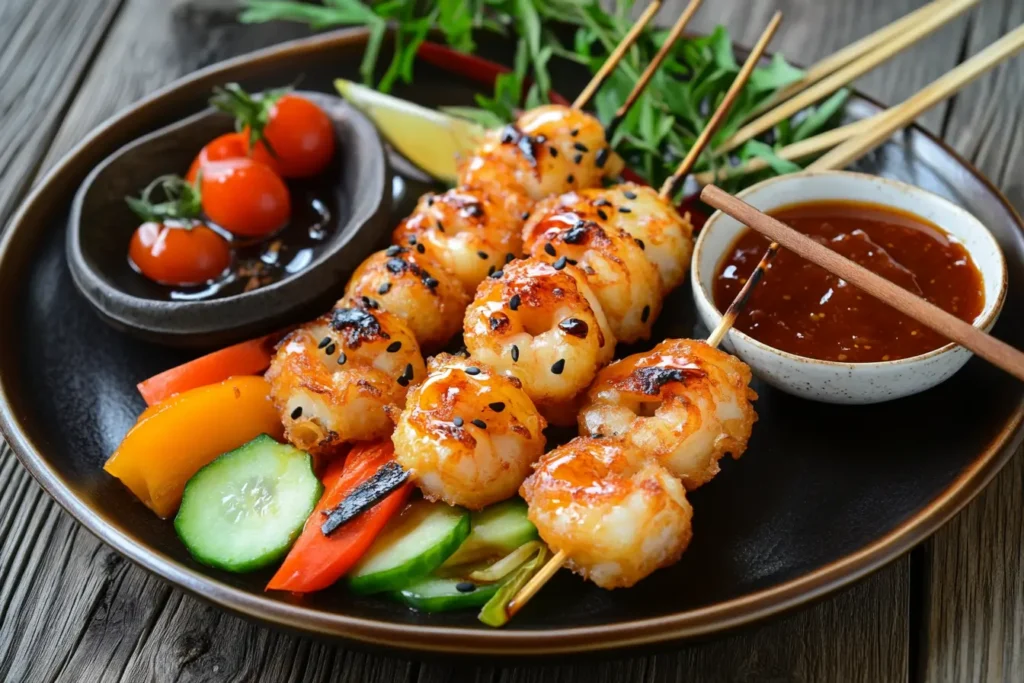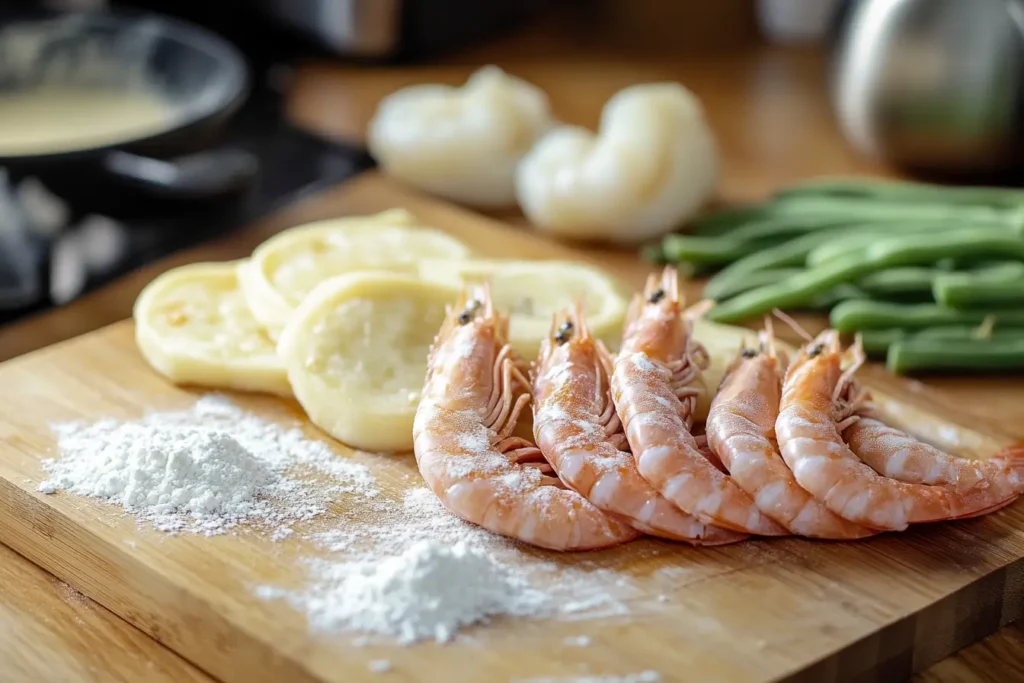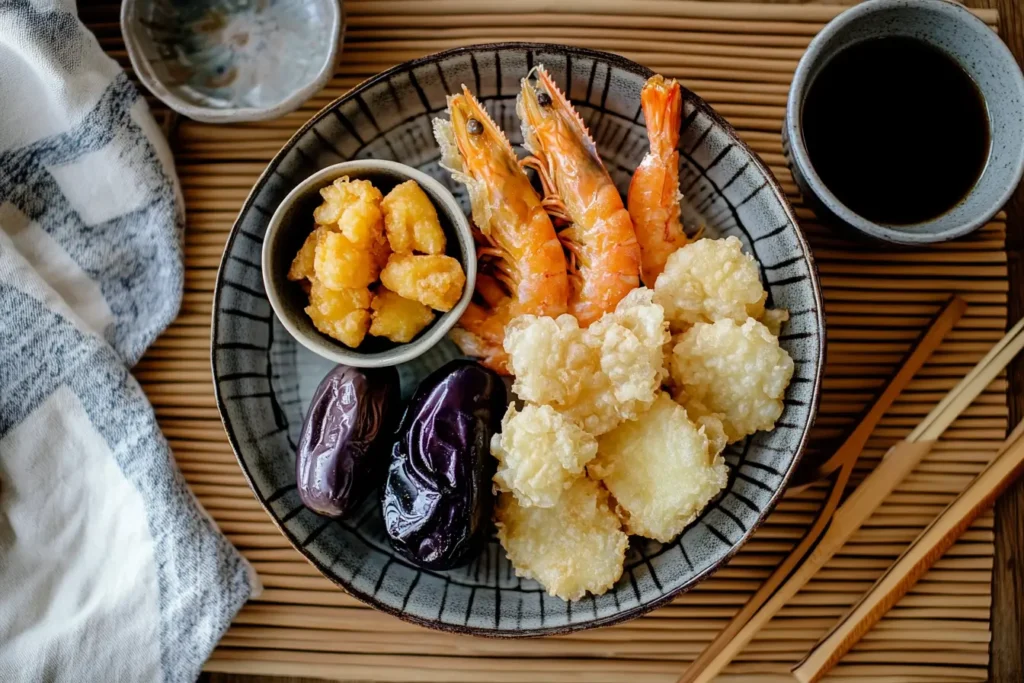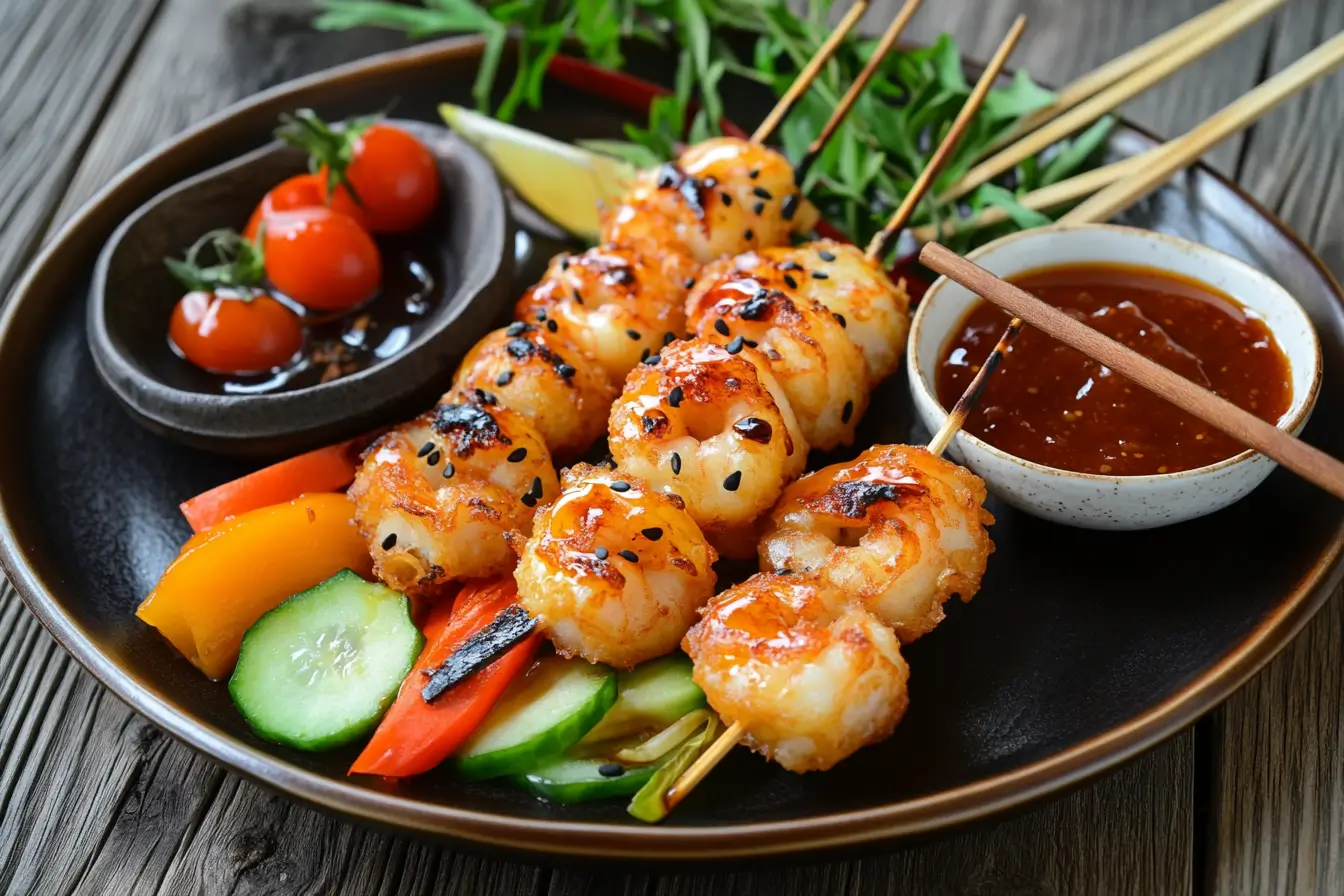
If you’ve ever bitten into a piece of tempura and marveled at its crispy, airy coating and perfect texture, you’ve probably asked yourself, “How do they make it so perfect?” Making tempura might seem like a mystery wrapped in batter, but the secret lies in a few key principles. This article will unravel the secrets of perfect tempura step by step, so whether you’re a kitchen novice or a seasoned chef, you’ll have all the tools to nail this Japanese favorite. Let’s dive in!
Introduction to Perfect Tempura: A Culinary Art
Tempura isn’t just food; it’s a culinary masterpiece that blends simplicity with sophistication. It’s light, crisp, and has a delicate flavor that lets the ingredients shine. But what makes tempura so unique?
The Origin and History of Tempura
Believe it or not, tempura’s roots aren’t entirely Japanese! It was introduced to Japan by Portuguese missionaries in the 16th century. They brought with them a cooking method that involved frying food in batter, and the Japanese transformed it into the iconic dish we know today.
Tempura was originally served during religious fasting periods—its name even comes from the Latin word “tempora,” meaning “time.” Over the centuries, it evolved into an everyday dish that’s celebrated worldwide.
“Tempura is more than just fried food; it’s an art form that showcases Japan’s dedication to precision and quality.”
Why Tempura Is Loved Worldwide
What’s not to love about perfect tempura? It’s versatile, pairs well with everything from rice to noodles, and can feature a wide range of ingredients. Whether you’re a seafood lover or a veggie enthusiast, tempura has something for everyone. Plus, its light texture is a refreshing change from heavier fried foods.
Key Components of Perfect Tempura
Let’s face it, not all tempura is created equal. The magic lies in balancing the right ingredients, batter, and technique.
The Role of Ingredients in Quality Tempura
When it comes to tempura, the ingredients are the stars of the show. Freshness is non-negotiable. Whether you’re using shrimp, eggplant, or sweet potatoes, they should be as fresh as possible. Why? Because fresh ingredients maintain their natural flavors and textures, even under a crispy coating.
Choosing the Right Vegetables and Seafood

Not all ingredients work well for tempura. The best ones are firm, low in water content, and flavorful. Here are some classics to try:
- Seafood: Shrimp, squid, white fish
- Vegetables: Sweet potatoes, bell peppers, eggplant, zucchini, green beans
💡 Pro Tip: Pat your ingredients dry before dipping them in batter. Excess moisture is the enemy of crispiness!
The Importance of Freshness in Ingredients
Imagine biting into a tempura shrimp that’s chewy or soggy. Freshness directly impacts the final texture and flavor, so don’t cut corners. Visit your local farmer’s market or seafood shop for the best produce.
The Perfect Tempura Batter
Ah, the batter—a delicate dance of ingredients that can make or break your tempura.
What Makes a Great Batter?
The key to a great batter is its simplicity. It’s usually just flour, egg, and ice-cold water. Yep, that’s it! But don’t be fooled; getting it right takes practice.
- Temperature matters: Keep the batter cold to prevent gluten development, which can make it heavy.
- Don’t overmix: A few lumps are okay! Overmixing will make the batter dense and chewy.
“Think of tempura batter as the supporting actor—it shouldn’t overshadow the star ingredients but highlight them beautifully.”
Classic Crispy Tempura Batter Recipe
Here’s a foolproof recipe for tempura batter:
- Ingredients:
- 1 cup all-purpose flour
- 1 egg (cold)
- 1 cup ice-cold water
- Instructions:
- Beat the egg in a bowl. Add the ice-cold water and mix gently.
- Gradually sift in the flour and stir lightly. Don’t worry about lumps—they’re fine!
Common Mistakes to Avoid When Making Batter
- Using warm water: This activates gluten, resulting in a dense batter.
- Letting the batter sit too long: Mix it just before frying for the best results.
- Overcoating the ingredients: A thin, even layer of batter works wonders.
Techniques for Frying Tempura
Frying might seem straightforward, but it’s where the magic happens—or doesn’t.
The Ideal Oil for Frying Tempura
Not all oils are created equal. You want something with a high smoke point and neutral flavor, like canola or vegetable oil. Traditionalists might use sesame oil for its subtle nuttiness.
Maintaining the Perfect Frying Temperature
Temperature is everything. The sweet spot is 350–375°F (175–190°C). Too hot? The batter burns. Too cold? It soaks up oil like a sponge. Use a thermometer if you’re unsure.
💡 Fun Tip: Drop a small bit of batter into the oil—if it sizzles and floats to the top immediately, you’re good to go.
Achieving a Crispy and Light Texture
Here’s the secret: fry in small batches. Overcrowding the pan drops the oil temperature, leaving you with soggy, sad tempura.
- Cook time: Most tempura is done in 2–3 minutes. Don’t overdo it!
- Drain well: Place fried pieces on a wire rack or paper towels to remove excess oil.
“Perfect tempura is all about balance—light, crispy, and never greasy.”
Common Problems in Tempura Preparation
Even with the best intentions, things can go wrong when making tempura. Don’t worry—mistakes happen, and every mishap is a learning opportunity. Let’s explore some common tempura problems and how to fix them.
Soggy Tempura: Causes and Solutions
There’s nothing more disappointing than soggy tempura. What went wrong? The usual suspects include improper oil temperature, a heavy batter, or excessive moisture in the ingredients.
Causes of Soggy Tempura
- Oil is too cold: Low oil temperature allows the batter to soak up oil instead of crisping up.
- Thick batter: A thick coating can trap steam, leaving you with a limp crust.
- Wet ingredients: Excess moisture interferes with the frying process.
Solutions for Perfect Crispiness
- Preheat and monitor your oil: Use a thermometer to maintain 350–375°F (175–190°C).
- Go light on the batter: Dip ingredients briefly and shake off the excess.
- Dry your ingredients: Use paper towels to remove as much moisture as possible.
Batter Falling Off Ingredients: How to Fix It
Have you ever noticed your tempura batter slipping off halfway through frying? This is a common issue but easy to resolve.
Why Does Batter Fall Off?
- Ingredients are too dry: Ironically, ingredients need a slight moisture layer for the batter to stick.
- Overhandling: Moving the ingredients too much in the oil can loosen the batter.
- Oil temperature fluctuation: Sudden drops in oil temperature can cause the batter to detach.
Quick Fixes
- Lightly dust with flour: Coat ingredients with a thin layer of flour before dipping them in batter.
- Handle gently: Once in the oil, let the tempura cook undisturbed for a few seconds before flipping.
- Use consistent heat: Avoid overcrowding the pan, which can lower the oil’s temperature.
Burnt or Uneven Tempura: Troubleshooting Tips
Nobody likes tempura that’s burned on one side and raw on the other.
Common Issues
- Oil temperature is too high: This can burn the batter before the inside cooks.
- Uneven cooking time: Ingredients of varying sizes and densities can cook at different rates.
- Improper oil depth: Shallow frying may lead to uneven coating and cooking.
How to Avoid Burnt or Uneven Tempura
- Use consistent oil temperature: Keep an eye on your thermometer and adjust the heat as needed.
- Cut ingredients evenly: Uniform sizes help everything cook at the same speed.
- Deep fry: Ensure the oil depth is sufficient to submerge the ingredients for even cooking.
“Perfect tempura isn’t just about ingredients—it’s about mastering the process. Every detail counts!”
Mastering Tempura Cooking Experience
Now that you’ve mastered the basics, let’s elevate your tempura game. From dips to presentation, these tips will take your dish from good to great.
Perfect Pairings: Dips and Sauces for Tempura
Tempura is amazing on its own, but pairing it with the right dip can make it extraordinary. The most traditional option? Tentsuyu sauce, a savory and slightly sweet blend of dashi, soy sauce, and mirin.
Classic Tentsuyu Recipe
- Ingredients:
- 1 cup dashi stock
- 1/4 cup soy sauce
- 1/4 cup mirin
- Grated daikon radish (optional)
- Instructions:
- Combine the dashi, soy sauce, and mirin in a saucepan.
- Heat gently, but don’t boil. Serve warm with grated daikon.
Other Dipping Sauce Options
- Spicy mayo: For a modern twist, mix mayonnaise with sriracha and a dash of lime juice.
- Ponzu sauce: A tangy, citrus-based alternative to traditional tentsuyu.
- Garlic aioli: Perfect for those who like bold flavors.
Serving Perfect Tempura: Presentation Tips

Let’s be honest—tempura is as much about aesthetics as it is about flavor. Presentation matters!
Tips for Plating Perfect Tempura
- Use a clean plate: The contrast of golden tempura against a white dish is visually appealing.
- Garnish thoughtfully: Add a sprig of parsley, a slice of lemon, or a small mound of grated daikon.
- Arrange with care: Place tempura pieces in an overlapping pattern or in a circle for an elegant touch.
💡 Pro Tip: Serve tempura immediately after frying. Nothing beats the taste of freshly fried tempura!
Variations of Perfect Tempura Around the World
Tempura may be quintessentially Japanese, but its influence has spread globally. Different cultures have their own unique takes on this crispy delight.
Regional Takes on Tempura in Japan
Did you know that tempura styles can vary across Japan?
- Kanto region: Known for using sesame oil, which gives tempura a golden color and nutty flavor.
- Kansai region: Uses lighter oils and batter for a more delicate result.
- Kyushu region: Features unique ingredients like lotus root and burdock.
“Exploring regional tempura styles is like tasting Japan’s culinary diversity one bite at a time.”
Perfect Tempura-Inspired Dishes in Other Cultures
Tempura has inspired countless dishes outside Japan:
- Korean twigim: A similar concept but often paired with spicy sauces.
- Indian pakoras: While not tempura per se, these fried treats share similarities in technique.
- Western adaptations: Think tempura-battered onion rings or fried chicken with tempura-style coatings.
🌍 Food Fact: Tempura has even influenced the global trend of frying ice cream, showing its versatility as a cooking method!
Frequently Asked Questions About Tempura
Even if you’ve nailed your tempura technique, there are always a few lingering questions. Let’s clear up some common doubts and provide insights to make your perfect tempura experience even better.
How Do Restaurants Achieve Perfect Tempura Consistently?
Restaurants have perfect tempura through a combination of high-quality equipment and time-honored techniques. They use industrial deep fryers to maintain consistent oil temperatures and often rely on pre-prepped ingredients that are primed for perfection.
Want to try restaurant-quality shrimp tempura at home? Check out What Is Shrimp Tempura Made Of? for tips on selecting and preparing shrimp.
Can Tempura Be Made Healthier Without Losing Taste?
Absolutely! For a healthier spin, you can:
- Use vegetable oils like canola or avocado oil for frying.
- Make vegetable-based tempura using ingredients like zucchini or green beans.
- Experiment with air frying for a lower-fat alternative.
For inspiration, explore this guide on Shrimp Straight for Tempura to ensure your shrimp is perfectly prepared while keeping health in mind.
What’s the Best Way to Serve and Enjoy Perfect Tempura?
Perfecting tempura recipes is best enjoyed fresh out of the fryer for maximum crispiness. Pair it with traditional dips like tentsuyu or modern sauces like garlic aioli. Presentation matters, too—arrange tempura neatly on a white plate for an appealing visual contrast.
Want more pairing ideas? Check out Fried Shrimp vs Tempura Shrimp to discover complementary flavors that elevate your tempura experience.
Conclusion: Mastering the Art of Perfect Tempura
So, what is the ultimate secret to perfect tempura? It’s all about mastering the trifecta: choosing the freshest ingredients, crafting a light and airy batter, and frying at the perfect temperature. While it takes some practice, the results are worth every effort.
“The beauty of tempura lies in its simplicity—each bite celebrates the true flavor of the ingredients wrapped in a crisp, golden embrace.”
For more delicious tempura recipes and insights, you might enjoy the Tempura Shrimp Recipe. And if you’re curious about the subtle nuances of tempura versus other fried foods, Fried Shrimp vs Tempura Shrimp provides a fascinating comparison.
Happy frying, and here’s to your perfectly crispy tempura creations! 🍤✨

